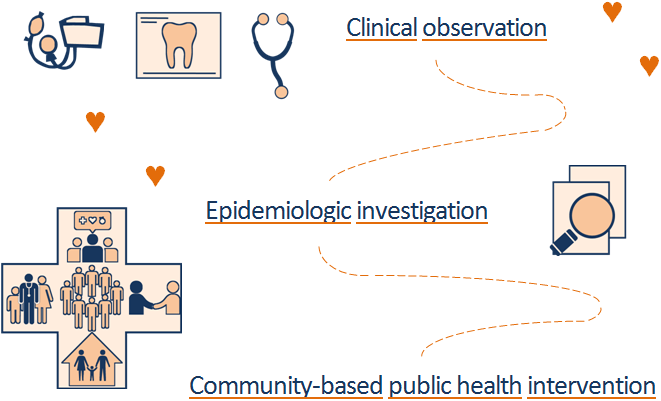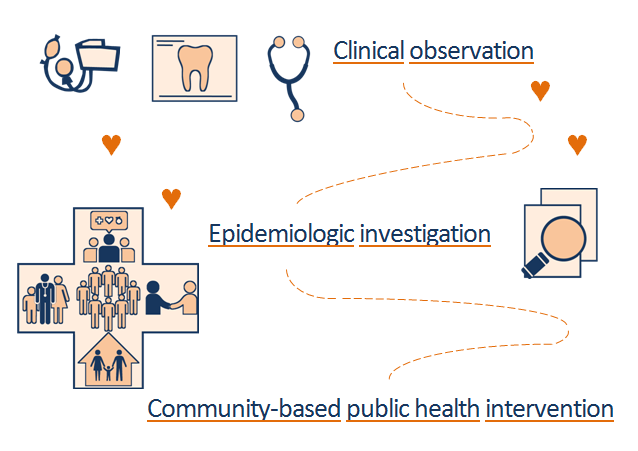- Why is there fluoride in our water?
- Why are there seat belts in our cars?
- Why are cigarette ads banned?
An illustration of a core concept in public health
Why is there fluoride in our water? If you're in a community that adds a little bit of fluoride to their water, the simple answer is because everyone benefits from fewer cavities.
And why are there seat belts in our cars? Again, the simple answer is to save lives during car crashes.
We talk a bunch about this concept and try to break it down in our broad overview of fluoride as one of CDC's public health achievements. We break it down there because our particular wording and conceptualization of this approach comes straight from CDC's write-up on fluoride as one of the ten great public health achievements in the 20th century.
But we thought this concept deserves its own We heart science page, too. Why? Well, first off, because we love the concept that much. But also ... we think defining it with a bunch of examples would be the perfect way to illustrate and explore this time-honored and core approach in public health.
Why ban cigarette ads? We can give a simple answer to that one, too. We've banned ads that promote kids starting up a habit that will give them cancer.
But those simple answers do *not* tell the whole story. No siree. There are deeper factors and influences at play here.
The deeper factors at play are from a particularly powerful approach from the field of public health: When clinical observation leads to epidemiologic investigation and community-based public health intervention.
This approach drove the discovery of fluoride as a cavity-preventing powerhouse.
It also drove a whole host of other public health achievements.
While dentists were observing fluorosis and cavities in the early 1900s, other doctors were observing injuries from car crashes and smoking habits in lung cancer patients in the 1920s -1950s.
And then ... just like how dental societies and researchers got the Public Health Service deep into studying the epidemiology of fluorosis, tooth decay, and their patterns with fluoride in the 1930s ... traffic safety became a whole new sub-field in epidemiology in the 1950s. And the Surgeon General convened panels in the early 1960s to tell the nation whether epidemiologic studies showed smoking causes cancer.
And then all of that led to interventions. Oral health epidemiology led to fluoride toothpastes and fluoridation, as well as control of fluorosis and rampant tooth decay. Epidemiologic studies of traffic safety led to safety standards for cars and highways. And epidemiologic reports from the Surgeon General led to Congress requiring warning labels and restrictions on advertising for cigarettes and a downturn in the number of smokers for the first time in four decades.
So clinical observation → epidemiology → intervention ... it's an important concept and approach in public health. And we love it. We think you'll love it, too, after you check out the details of these examples of why there is fluoride in our water and toothpastes, seat belts in our cars, and bans on cigarette ads ...
So ... the answers to these questions - Why is there fluoride in our water? Why are there seat belts in our cars? Why are there bans on cigarette ads? - are not just simple, indeed. There is a whole lot of in-depth science and a powerful evidence-based approach to wellness behind them.
Fluoride and fluoridation. Seat belts. Cigarette ad bans. They are three classic examples of how public health progresses from clinical observation, to epidemiologic investigation, to community-based interventions.
Of course, there are lots more public health achievements that follow this pattern, too, so we should review – one more time - the core public health concept itself:
Clinical observation
Doctors &
dentists
observe
lots of
patients
and come
up
with hypotheses
Epidemiology
Meticulous,
methodical,
hardcore science,
analysis, and
in-depth study
Public health intervention
Act on our hard-
won knowledge
to
prevent
disease &
promote health
We love science, and we love this pattern of how observations, epidemiology, and interventions lead to a healthier America.
You may also love
What is public health?
Who is CDC?
- We love science
- We love public health
About We ❤science
features
- We love science
We love references
For more links, citations, and details on each intervention in this article, go to:
References for Why is there fluoride in our water, why are there seat belts in our cars, and why are there bans on cigarette ads


